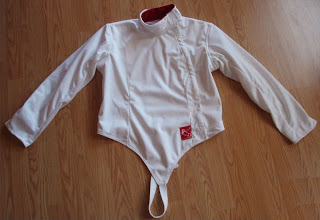Man he's a sexy beast!!!
What many people don’t know is that fencing is actually a collection of sports that feature weapons such as swords, knives, pikes (long spears), bayonets, batons, and clubs. There are three categories of competition which are featured in the Olympic Games. They include:
• Foil- A lightweight thrusting weapon. Acceptable targets include the chest, torso, shoulders, and back.
• Epee- A heavy thrusting weapon. Any part of the body can be targeted.
• Sabre- A cutting and thrusting weapon. The only targets are the saddle line, which extends across the hip, as well as the head.
Rather than described the rules of each category, I’ve decided to dedicate the rest of this article to describe the foil method, which is the style most think of.
Did you know?- Wheelchair fencing, also known as jousting, is a Paralympics sport. Minor modifications to the rules allow disabled fencers to fence all three weapons. Footwork is replaced by torso or arm movement, depending on the fencer's disability. The proximity of the two fencers tends to increase the pace of bouts, which require considerable skill.
Like a lot of sports, if you’re new to watching fencing you’ll probably have no idea what’s going on. Just as with the majority of American athletics, in fencing a winner is chosen upon a point system. Specifically in foil, score is kept by counting the number of hits which land on the opponent’s target area. These hits are called ‘touches’. When a player has been struck, the judge will yell “Halt!” signaling the end of the round. Bouts are scored to either five or fifteen touches.
Now it gets complicated….There are rules that govern the priority of a hit when opponents strike one another simultaneously. This guideline is referred to as the “right of way.” When a person is attacked, the opposite fencer must either avoid or defend against the attack to be awarded a touch. If the opponent ‘parries’, or blocks, the attack, he/she has the right to ‘riposte’ or counter-attack. Counter-attacks only score if the attacker misses. Even if the attacker’s strike misses its target, it still takes priority over the opponent’s valid hit.
Below is a list of all the protective equipment required in professional fencing.
breeches
gloves
jacket
mask
plastron
Did you know?- As fencers’ strikes became quicker judges were having a difficult time scoring bouts by eye. This problem was eliminated with the invention of electric fencing equipment. It works by sending an electric current through the sword which when striking the target area completes the circuit causing a light on the end of the sword to light up.
Fencing is a great sport to build muscle speed and hand-eye coordination. To ensure no one gets hurt in your learning process, it’s recommended you start with a practice weapon which is considerably cheaper than electric models. Two websites that offer practice foils starting at $25 are blade-fencing.com and shop.fencing.net.











No comments:
Post a Comment